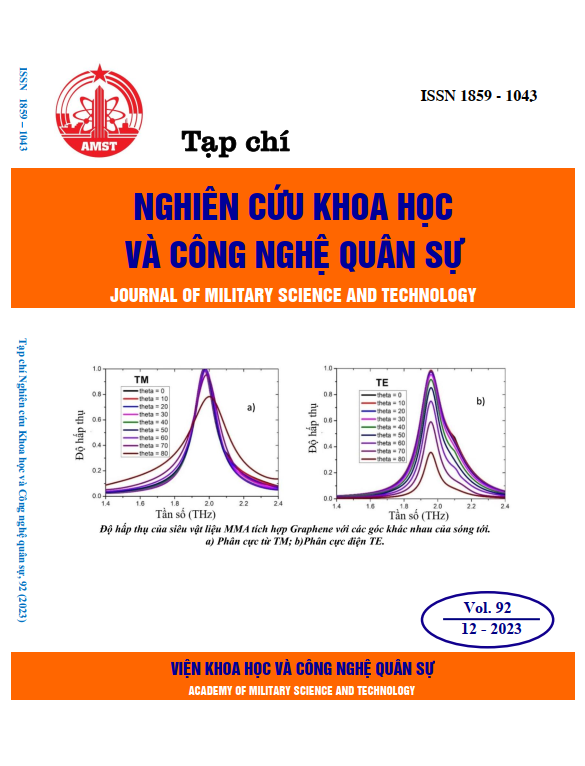Nghiên cứu chế tạo và đánh giá một số tính chất của vật liệu nano lưỡng kim Fe/Cu hóa trị 0 bằng phương pháp hóa học xanh
602 lượt xemDOI:
https://doi.org/10.54939/1859-1043.j.mst.92.2023.46-54Từ khóa:
Fe/Cu; Vật liệu nano lưỡng kim; Hóa trị 0; Lá trà xanh.Tóm tắt
Bài báo giới thiệu kết quả nghiên cứu chế tạo vật liệu nano lưỡng kim Fe/Cu hóa trị 0 bằng tác nhân polyphenol được chiết xuất từ lá trà xanh Việt Nam. Ảnh hưởng của một số yếu tố đến quy trình chế tạo đã được nghiên cứu, cho thấy, nano lưỡng kim Fe/Cu hóa trị 0 có chất lượng tốt nhất khi phân tán trong hỗn hợp dung môi ethanol/H2O 4/1(v/v); nồng độ polyphenol trong dịch chiết trà xanh 12,5 g/L; tỷ lệ Fe/Cu là 5/1, pH = 3 - 4, nhiệt độ 25 - 28 oC. Vật liệu nano lưỡng kim Fe/Cu có hoạt tính duy trì ổn định trong 35 ngày, d = 0,921 g/cm3, kích thước hạt 37 - 45 nm và chứa các nhóm hydroxyl trên bề mặt.
Tài liệu tham khảo
[1]. Tiziana Tosco et al., “Nanoscale zerovalent iron particles for groundwater remediation: a review”, Journal of Cleaner Production, 77, pp. 10-21, (2014). DOI: https://doi.org/10.1016/j.jclepro.2013.12.026
[2]. Denis O’Carroll, et al, “Nanoscale zero valent iron and bimetallic particles for contaminated site remediation”, Advances in Water Resources, 51, pp. 104-122, (2013). DOI: https://doi.org/10.1016/j.advwatres.2012.02.005
[3]. Nannan Qin et al., “Enhanced removal of trace Cr(VI) from neutral and alkaline aqueous solution by FeCo bimetallic nanoparticles”, Journal of Colloid and Interface Science, 472, pp. 8-15, (2016). DOI: https://doi.org/10.1016/j.jcis.2016.03.025
[4]. Shimin Zhou et al., “Enhanced Cr(VI) removal from aqueous solutions using Ni/Fe bimetallic nanoparticles: characterization, kinetics and mechanism”, RSC Advances, 4(92), pp. 50699-50707, (2014). DOI: https://doi.org/10.1039/C4RA08754B
[5]. Pengjun Li et al., “Enhanced nitrate removal by novel bimetallic Fe/Ni nanoparticles supported on biochar”, Journal of Cleaner Production, 151, pp. 21-33, (2017). DOI: https://doi.org/10.1016/j.jclepro.2017.03.042
[6]. Thabet Tolaymat et al., “Analysis of metallic and metal oxide nanomaterial environmental emissions”, J. Clean. Prod., 143, pp. 401-412, (2017). DOI: https://doi.org/10.1016/j.jclepro.2016.12.094
[7]. Kesarla Mohan Kumar et al., “Biobased green method to synthesise palladium and iron nanoparticles using Terminalia chebula aqueous extract”, Spectrochimica Acta Part A: Molecular and Biomolecular Spectroscopy, 102, pp. 128-133, (2013). DOI: https://doi.org/10.1016/j.saa.2012.10.015
[8]. V.R. Sinija, et al., “Process technology for production of soluble tea powder”, Journal of Food Engineering, 82(3), pp. 276-283, (2007). DOI: https://doi.org/10.1016/j.jfoodeng.2007.01.024
[9]. Trần Văn Nhân, “Giáo trình Hóa keo”, Nhà xuất bản Đại học Quốc gia Hà Nội, (2007).
[10]. Wei‐xian Zhang, “Nanoscale iron particles for environmental remediation: An overview”, Journal of Nanoparticle Research, 5, pp. 323-332, (2003). DOI: https://doi.org/10.1023/A:1025520116015
[11]. Foad Kazemi et al., “Photodegradation of methylene blue with a titanium dioxide/polyacrylamide photocatalyst under sunlight”, Journal of Applied Polymer Science, 133, p.43386, (2016). DOI: https://doi.org/10.1002/app.43386
[12]. Fatemeh Rezaei, et al., “Effect of pH on zero valent iron performance in heterogeneous Fenton and Fenton-like processes: A review”, Molecules, 23(12), pp. 3127-3145, (2018). DOI: https://doi.org/10.3390/molecules23123127
[13]. Hiroyuki Yoshino et al., “A phenomenological reaction kinetic model for Cu removal from aqueous solutions by zero-valent iron (ZVI)”, Chemosphere, 200, pp. 542-553, (2018). DOI: https://doi.org/10.1016/j.chemosphere.2018.02.127
[14]. T. Wang et al., “Green synthesized iron nanoparticles by green tea and eucalyptus leaves extracts used for removal of nitrate in aqueous solution”, Journal of Cleaner Production, 83, pp. 413-419, (2014). DOI: https://doi.org/10.1016/j.jclepro.2014.07.006
[15]. Ahmed M. Abdelfatah et al., “Green synthesis of nano-zero-valent iron using ricinus communis seeds extract: Characterization and application in the treatment of methylene blue-polluted ưater”, ACS Omega, 6(39), pp. 25397-25411, (2021). DOI: https://doi.org/10.1021/acsomega.1c03355







